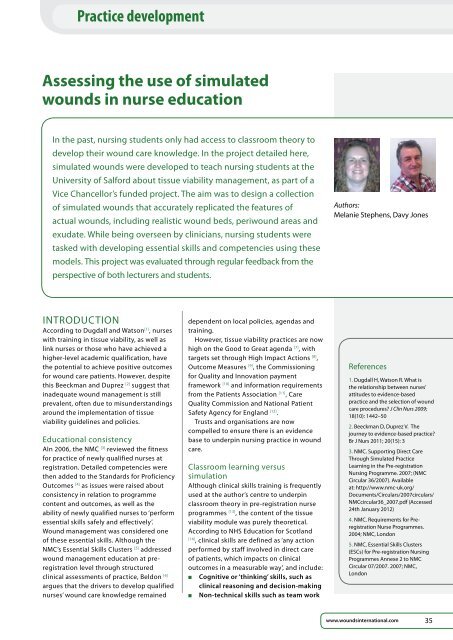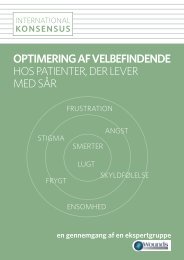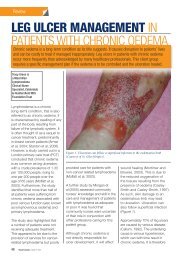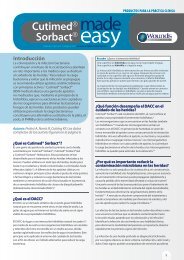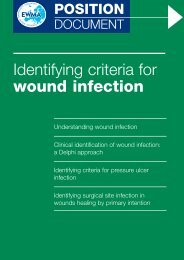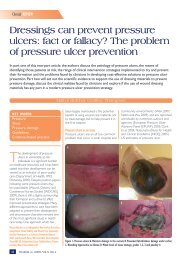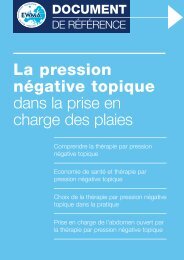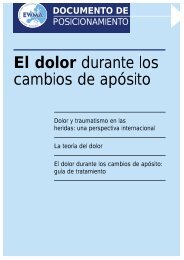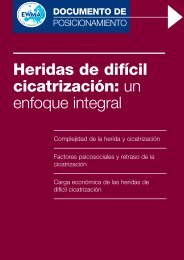VIEW PDF - Wounds International
VIEW PDF - Wounds International
VIEW PDF - Wounds International
Create successful ePaper yourself
Turn your PDF publications into a flip-book with our unique Google optimized e-Paper software.
Practice development InnovationsPractice developmentAssessing the use of simulatedwounds in nurse educationIn the past, nursing students only had access to classroom theory todevelop their wound care knowledge. In the project detailed here,simulated wounds were developed to teach nursing students at theUniversity of Salford about tissue viability management, as part of aVice Chancellor’s funded project. The aim was to design a collectionof simulated wounds that accurately replicated the features ofactual wounds, including realistic wound beds, periwound areas andexudate. While being overseen by clinicians, nursing students weretasked with developing essential skills and competencies using thesemodels. This project was evaluated through regular feedback from theperspective of both lecturers and students.Authors:Melanie Stephens, Davy JonesIntroductionAccording to Dugdall and Watson [1] , nurseswith training in tissue viability, as well aslink nurses or those who have achieved ahigher-level academic qualification, havethe potential to achieve positive outcomesfor wound care patients. However, despitethis Beeckman and Duprez [2] suggest thatinadequate wound management is stillprevalent, often due to misunderstandingsaround the implementation of tissueviability guidelines and policies.Educational consistencyAIn 2006, the NMC [3] reviewed the fitnessfor practice of newly qualified nurses atregistration. Detailed competencies werethen added to the Standards for ProficiencyOutcomes [4] as issues were raised aboutconsistency in relation to programmecontent and outcomes, as well as theability of newly qualified nurses to ‘performessential skills safely and effectively’.Wound management was considered oneof these essential skills. Although theNMC’s Essential Skills Clusters [5] addressedwound management education at preregistrationlevel through structuredclinical assessments of practice, Beldon [6]argues that the drivers to develop qualifiednurses’ wound care knowledge remaineddependent on local policies, agendas andtraining.However, tissue viability practices are nowhigh on the Good to Great agenda [7] , withtargets set through High Impact Actions [8] ,Outcome Measures [9] , the Commissioningfor Quality and Innovation paymentframework [10] and information requirementsfrom the Patients Association [11] , CareQuality Commission and National PatientSafety Agency for England [12] .Trusts and organisations are nowcompelled to ensure there is an evidencebase to underpin nursing practice in woundcare.Classroom learning versussimulationAlthough clinical skills training is frequentlyused at the author’s centre to underpinclassroom theory in pre-registration nurseprogrammes [13] , the content of the tissueviability module was purely theoretical.According to NHS Education for Scotland[14], clinical skills are defined as ‘any actionperformed by staff involved in direct careof patients, which impacts on clinicaloutcomes in a measurable way’, and include:n Cognitive or ‘thinking’ skills, such asclinical reasoning and decision-makingn Non-technical skills such as team workReferences1. Dugdall H, Watson R. What isthe relationship between nurses’attitudes to evidence-basedpractice and the selection of woundcare procedures? J Clin Nurs 2009;18(10): 1442–502. Beeckman D, Duprez V. Thejourney to evidence-based practice?Br J Nurs 2011; 20(15): 33. NMC. Supporting Direct CareThrough Simulated PracticeLearning in the Pre-registrationNursing Programme. 2007; (NMCCircular 36/2007). Availableat: http://www.nmc-uk.org/Documents/Circulars/2007circulars/NMCcircular36_2007.pdf (Accessed24th January 2012)4. NMC. Requirements for PreregistrationNurse Programmes.2004; NMC, London5. NMC. Essential Skills Clusters(ESCs) for Pre-registration NursingProgrammes Annexe 2 to NMCCircular 07/2007. 2007; NMC,Londonwww.woundsinternational.comwww.woundsinternational.com3535
Practice developmentReferences6. Beldon P. Is wound managementtraining in primary care goodenough? Br J Comm Nurs. 2010;15(9): 297. DoH. NHS 2010–2015: From Goodto Great. Preventative, Peoplecentred,Productive. 2009a; DoH,London8. NHS Institute for Innovationand Improvement. High ImpactActions for Nursing and Midwifery.Available at: http://www.institute.nhs.uk/building_capability/hia_supporting_info/your_skin_matters.html. 2009; (accessed 8November, 2011)9. DoH. Quality and OutcomesFramework. 2009b; DoH, London10. DoH. Using the Commissioningfor Quality and Innovation (CQUIN)payment framework. 2008a; DoH,London11. The Patients Association .Meaningful and comparableinformation: Tissue Viability NursingServices and Pressure Ulcers. 2010;The Patients Association, Middlesexnand communicationTechnical skills, such as clinicalexamination and invasive procedures.However, it is widely acknowledged thatdecision-making skills seldom develop inthe classroom setting [15] and Benner [16]recognises that it is only when theory isapplied to practice that students learn todeliver care safely.Despite this, many post-registrationcourses, study days and conferences remainheavily theoretical. A Cochrane Systematicreview [17] found that a mix of didactic andinteractive education was more effectivethan either method alone.Therefore, it is now recognised thatsimulated environments can help lecturersconstruct interactive patient situations thatprovide students with skills training as wellas linking theory to practice [18] . The benefitsof simulated learning include:n Critical thinkingn Confidencen Decision makingn Skills development [19] .Simulated patient scenarios also allowstudents to integrate skills from differentdomains of learning and receive immediatefeedback [20] .It is important to explore the possibility ofproviding learning activities that incorporatesimulated wounds and which are designed tomeet the outcomes of educational modules.This will assist in bridging the theory/practicegap and help to develop students’ confidencein performing wound care skills.Simulated woundsThere are many companies manufacturingsimulated wounds and some schools ofnursing make their own, some of which areplaced on actors or student nurses involvedin the clinical simulation.They are usually made of rubber andare mostly classified as low fidelitysimulators because although they areuseful for skills training they are not asanatomically realistic as medium or highfidelitysimulators or as able to mimicdiverse physical parameters [21] . Low fidelitysimulated wounds also require addedmoulage (the art of applying and making upmock injuries for the purposes of trainingby clinicians) to assist in the ‘suspension ofdisbelief’ [22] .Salford simulatedwounds projectThe wound models made for the Universityof Salford project are considered mediumfidelity, meaning they realisticallydepict wounds seen in clinical practiceand promote realistic responses fromstudents [21] .Compared with low fidelity models, thesewounds contain greater detail in relation to:n Anatomical sizen Physiology: when viewed by studentsthe wounds make sense in relationto the causative factors of skinbreakdown, for example, a modeldesigned to resemble a pressure ulcercaused by shear and pressure willlook like a real ulcer as it will havethe typical ‘teardrop’ shape and anundermined cavityn Tissue: granulation tissue, for example,will be red and look granular, sloughwill be yellow and stringy and necrotictissue will be able to be debrided[Fig 1]n Skin: the simulated wound can beblended to the actor’s skin so it is moreconvincing — students will be unableto tell where the real skin beginsn Feel: the simulated wounds aremade with silicone and replicate thesensation of real wounds.Extra blood, exudate and slough areregularly added to the wounds for effectand can be absorbed into any dressings thatare applied.Project developmentThe development of six large simulatedchronic wounds and 12 smaller woundswere funded solely from monies awardedfrom a Vice Chancellor Scholarship withinthe university.The simulated wounds were designedby special effects and make-up artist, DavyJones, and lecturer in adult nursing, MelanieStephens. The wounds were sculpted andmoulded to replicate the chronic and acutewounds seen in clinical practice. Jonesmanufactured resin moulds, which couldthen be used on real people.From the resin moulds Jones thenproduced the wounds as gel-filled siliconeappliances. Along with his team, Jones handpainted all the models, making sure he had36<strong>Wounds</strong> <strong>International</strong> Vol 3 | Issue 3 | ©<strong>Wounds</strong> <strong>International</strong> 2012
????????????????????Practice development: Assessing the use of simulated wounds in nurse education?????????????????????????????????????Figure 1. Debridement of a simulated pressure ulcer wound.regular discussions with Stephens abouthow the wounds would look and feel.The chronic wound models producedincluded:n Buttocks with multiple pressure ulcersof varying depth, category and healingn A fungating breast woundn A dehisced abdominal wound withstoman A necrotic heel ulcern A dehisced cardiac woundn A leg ulcer.The 12 smaller models included incisionwounds, ulcers, healing wounds and smallburns.All the models were based on factualpatient case studies. This was so thestudents could experience the wounds asthey were observed in practice and alsolearn about real ‘back-stories’ and patientoutcomes.The simulated wounds were usedto augment the theoretical content of atissue viability module. The introductionof the models provoked debate aroundthe assessment and management ofeach case.Project examplesSimulation of a fungating breast woundThe simulation of a fungating breast woundwas based on a patient referred to thetissue viability services by a local group ofpharmacists who had noticed her regularlybuying large rolls of gamgee.This type of wound was chosen so thatstudents could learn that healing is notalways the objective of wound management— the goals for this particular patientincluded the absorption of exudate and thereduction of odour and bulk as the patientpreferred to wear T-shirts in the summerinstead of polo neck jumpers and a coat.The simulation needed to replicate thevisual appearance of a fungating wound,but also have both breasts present.Therefore, when constructing the wound,Jones needed to sculpt on a real womanand then build up the fungating area toreplicate the original wound [Fig 2].Simulation of a pressure ulcerA necrotic pressure ulcer on the heel ofa foot was based upon a patient whohad undergone a hemiarthroplasty. Thisenabled students to explore pressure ulcerReferences12. Guy H. Now is the time for tissueviability. 2011; Br J Nurs 20(11): 3013. Rennie I. Exploring approachesto clinical skills development innursing education. 2009; Nurs Times105(3): 20–2214. NHS Education for Scotland (2007)Partnerships for Care. TakingForward the Scottish Clinical SkillsStrategy. NES, Edinburgh15. Gallagher AG, Ritter ME, ChampionH, Higgins G, Moses G, Smith DC,Satava RM. Virtual reality simulationfor the operating room: proficiencybased training as a paradigm shiftin surgical skills training. 2005; AnnSurg 241(2): 364–7216. Benner P. From Novice to Expert:Excellence and Power in ClinicalNursing Practice. 1984; Addison-Wesley, California17. Forsetlund L, Bjorn dal A, RashidinA, Jamtvedt G, O’Brien MA, WolfF, Davis D, Odgaard-Jensen J,Oxmon AD. Continuing EducationMeetings and Workshops: Effects onProfessional Practice and HealthcareOutcomes. 2009; Available onlineat: http://onlinelibrary.wiley.com/doi/10.1002/14651858.CD003030.pub2/abstract;jsessionid=ACBE98E30D293C1470DB775551050E19.d02t02(accessed 20 January, 2012)www.woundsinternational.com37
Practice developmentFigure 2 (left). Simulation of a fungating wound after debridementFigure 3 (right). Necrotic pressure ulcer on the heel of the foot.References18. Wolfgram LJB, O’Leary-QuinnA (2011) Integrating simulationinnovatively: evidence inteaching nursing education. ClinSim Nurs Available at: http://www.sciencedirect.com/science/article/pii/S1876139910001660(accessed 26, July 2011)19. Nehring WM, Ellis WE, LashleyFR. Human patient simulators innursing education: An overview.Simulation and Gaming. 2001;32(2): 194–20420. Kneebone R, Kidd J, Nestel D,Asvall S, Paraskeva P, Darzi, A. Aninnovative model for teachingand learning clinical procedures.2002; Medical Educ 36: 628–3421. Lapkin S, Levett-Jones T,Bellchambers H, FernandezR. Effectiveness of patientsimulation manikins in teachingclinical reasoning skills toundergraduate nursing students:a systematic review. 2010; ClinSim Nurs 6: 207-22222. Kreger NE. Five fast fixes. 2009;Clin Sim Nurs 5: e8523. Moule P, Wilford A, Sales R,Haycock L, Lockyer, L. Can theuse of Simulation Support PreregistrationNursing Students inFamiliarising Themselves withClinical Skills before Consolidatingthem in Practice? Faculty of Healthand Social Care. 2006; Universityof the West of England (UWE),Bristoldevelopment, wound assessment andremoval of necrotic tissue. The simulatednecrosis was designed to be separate fromthe ulcerated heel [Fig 3]. Jones addedlayers of simulated sloughy tissue to thewound bed and then placed the necrotictissue on top.Simulation of a dehisced abdomen with astoma siteA dehisced abdomen with a stoma site wasbased upon a patient who had infecteddiverticulitis and had undergone an urgenthemicolectomy and stoma formation. Thewound had dehisced post-surgery and washealing by secondary intention.The rationale for including this wound wasfor students to explore the managementof a heavily exuding wound that wasfurther compounded by a stoma site. Italso provided the opportunity to considerthe patient’s goal of going home withoutexperiencing wound leakage [Fig 4].Simulation of a leg ulcerA simulated leg ulcer was designed [Fig5] so that it could be stuck to the leg ofan actor. The aim was to assist students indeveloping knowledge and assessmentskills around venous leg ulcer management.The ulcer and surrounding skin needed todisplay signs of venous hypertension as wellas an ulcerated wound bed with moderateexudate.OutcomesAt the end of the 16-week programme, thestudents’ responses were collated using aLikert scale. They were asked:nnnWhether using the simulated woundsaided learning?What was the usefulness of thesimulated wounds to their practice?For any other comments studentswanted to make about the wounds.From the 16 students who providedfeedback, it was found that:n All strongly agreed that the woundshelped their learningn All strongly agreed that they found thewounds useful to their practice.General comments included:n ‘I found the practical session mostuseful’n ‘The wounds related so well to ourplace of work’n ‘Practical demonstrations usingthe wound care model were reallybeneficial’n ‘The opportunity to discuss theproblems associated with the wounds,whilst they were in front of you, andthen to develop familiarity with woundassessment and management, aidedmy learning’.The lecturer found that the simulatedwounds enabled greater discussion of tissueviability practice and that students couldbetter relate to the wounds seen in practice.It also helped them to deal better with thecomplexities of assessment, managementand treatment.DiscussionThe NMC [3] strongly supports the use of38<strong>Wounds</strong> <strong>International</strong> Vol 3 | Issue 3 | ©<strong>Wounds</strong> <strong>International</strong> 2012
Practice development: Assessing the use of simulated wounds in nurse educationFigure 4. Dehisced abdomen with a stoma site.Zone of Proximal Development, appearsto be undervalued [24] . Daniels impliesthat learners’ knowledge and skillsdevelopment is reduced when they have toindependently solve problems, rather thanhaving the input of more capable peers.Therefore, if the lecturer ‘scaffolds’ thelearning experience with academic supportand peer learning, students’ knowledge,skills and problem-solving abilities increase.By using simulated models, the Universityof Salford project enabled students todiscuss their practice in a safe environmentand learn from each other.Although this method may not take intoaccount students’ learning style, ability orcurrent levels of knowledge, according toGrundy [25] learning in this way can achievethe same outcomes as pre-registrationnursing programmes.Although this project is limited bythe small number of self-reportedstudent evaluations, the feedback wasunequivocal in demonstrating that thesimulated wounds aided students’ learningexperience.A systematic review on the effectivenessof simulation in teaching clinical reasoningskills to undergraduates [21] suggests thatalthough the evidence is inconclusive,knowledge and skills acquisition issignificantly improved. This project providesa call for future research and work in thisfield.Practice DevelopmentFigure 5. Simulated leg ulcer.simulation as an opportunity for nursesto rehearse and consolidate skills priorto practice. Case studies using simulatedwounds have highlighted that they canincrease students’ confidence, skills anddecision-making capabilities [23] .The government’s quality agenda andoutcome measures are aimed at reducingwound care expenditure in trusts, whileat the same time providing increasedsafety and effectiveness of care [9] . Woundcare simulation enables students to gainknowledge and understanding in a safeenvironment.Vicarious learning, where knowledge isgained by observing the consequencesof others’ actions, such as in Vygotsky’sConclusionThe purpose of this project was to developa set of simulated wounds that were morerealistic and life-like than those previouslyavailable, therefore, enhancing the learningexperience for nursing students.Although this project only included asmall number of evaluations, it highlightsthat wound simulation can offer educatorsin the field of tissue viability an effectiveway to prepare clinicians for the types ofwounds that they will see on real patients.Author detailsMelanie Stephens is lecturer in Adult Nursingand <strong>International</strong> Pre-Registration Link Lead,School of Nursing, Midwifery and Social Work,University of Salford, Greater ManchesterDavy Jones is Make up, Special Effects andProsthetics Artist, MakeupSFX Workshop,LiverpoolReferences24. Daniels H. An Introduction toVygotsky. 1996; Routledge, London25. Grundy L. Pathways to fitnessfor practice: national vocationalqualifications as a foundation ofcompetence in nurse education.2001; Nurse Educ Today 21: 260–65www.woundsinternational.com39


